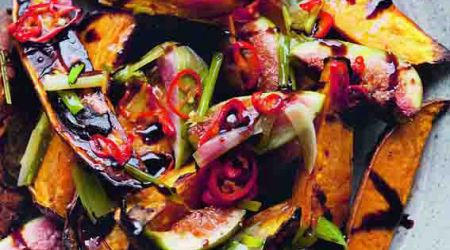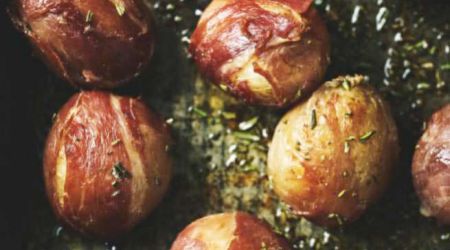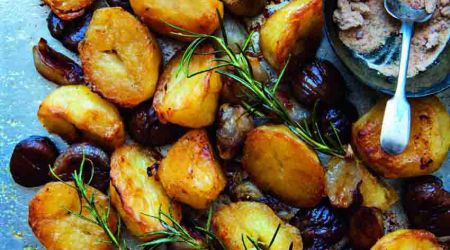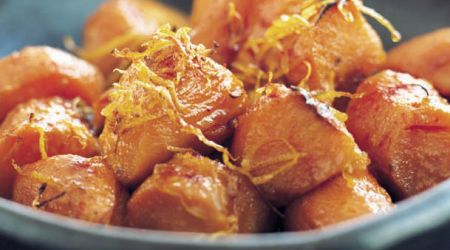Potatoes
The wonder of the potato is that so much can be created from so little. Yet this humble tuber was once regarded with suspicion and fear, says Clarissa Hyman with recipes by Linda Tubby
It’s hard to imagine a world without rich buttery mash and salty French fries, but when the potato (Solanum tuberosum), arrived in Europe in the 16th century courtesy of Spanish explorers, it certainly wasn’t an instant hit. Early potato varieties were small and bitter; they were also thought to be poisonous, because the Solanum genus includes the plant deadly nightshade. In Scotland, preachers considered potatoes to be unfit food because they were not mentioned in the Bible. It wasn’t until the 18th century that fears subsided and potatoes become one of Europe’s staple foods.
Native to the Americas, the potato was first cultivated in the Andean highlands of Peru where maize could not be grown. The name comes from batata, the Spanish word for sweet potato, and remains patata in both Spanish and Italian today.
Potatoes are now grown in every cool climate of the world, although neither the leaves nor tubers can tolerate frost. Loose-skinned new potatoes planted in February through March are usually dug from April to June. Main crops are harvested in September and October and stored for use during the winter. More recently, there has been something of a potato renaissance with most potatoes now identified and labelled by variety and use.
Happily, we have also begun to regain a sense of seasonality, starting with the earliest Cornish, Jersey and Pembroke new potatoes, although some fast-growing varieties, pushed to appear on the shelves earlier and earlier, can still be watery and tasteless. Traditional loose-skinned early potatoes (scrub don’t peel) dehydrate rapidly, and will not keep for more than a week. And while you can buy ‘new potatoes’ in winter, they will have been cold-stored for months and are likely to have lost much of their sweetness.
Main-crops, harvested in September and October, including essential Bonfire Night ‘bakers’, can be stored easily for use during the winter. Old-crops refer to potatoes whose skins have become set, and provided they are stored in a paper bag in dark and cool but frost-free conditions, should keep for weeks or even months. From Christmas onwards, potatoes start to prepare for spring and may sprout; provided they have not turned green, it is safe to remove the sprouts and use them in the usual way.
Waxy and floury potatoes differ immensely, and the choice of varieties depends on use. Waxy ones with low dry-matter content, such as Maris Peer and Charlotte, are good for boiling and perfect for salads. Floury potatoes with high dry matter such as King Edward are excellent for fluffy mash, chips, roasting and baking. All-rounders include Estima, Desiree and Maris Piper.
More specialist varieties such as Pink Fir Apple and Kerr’s Pink are worth tracking down, though the home gardener may find them tricky to cultivate. Farmers’ markets and specialist suppliers such as Carroll’s Heritage Potatoes in Northumberland (heritage-potatoes.co.uk) now offer a wonderful range of old-fashioned varieties, in a wealth of colours, shapes and strikingly different flavours.
There is little you can’t do with a potato – except eat it raw. Numerous indeed are the forms in which it can be cooked and served: boiled, baked, mashed, fried and cold in salad. Crunchy potatoes roasted under the joint are one of the triumphs of the British table, as is lush, butter-rich mash, and boiled tiny new potatoes with mint and melted butter. In France, they are cooked with cream in gratin dauphinoise or baked in transparent slices for pommes Anna. The Italians sautée them with garlic and rosemary, and in Spain potatoes make the definitive tortilla. German potato salads are spicy with vinegar and sharp with capers and onion; jumbo American baked potatoes overflow with sour cream and chives; colcannon and champ are an Irish way of life; and potato latkes are the quintessential Jewish accompaniment to salt beef.
In the 19th century, Brillat-Savarin dismissed the potato as eminently tasteless and useful only as a protection against famine. If only he could have time-travelled into the future and sampled the sublime pommes purée of his fellow countryman Joël Robuchon, his verdict would doubtless have been very different.

Recipes
Get Premium access to all the latest content online
Subscribe and view full print editions online... Subscribe




